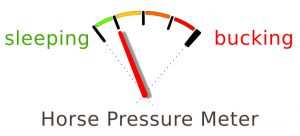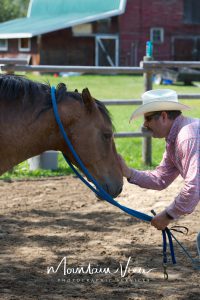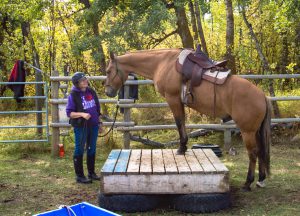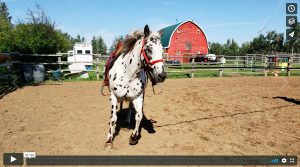I’d like to introduce five of our Strategies for Success that we follow when we start working with horses on obstacles or anything new and unknown.
- We build it in the groundwork, then ride it in the saddle.
- We never force a horse to go on, over or though something they’re scared of. We do go forward when the horse is in release and following our focus.
- Find ground zero. This is the position, proximity to an obstacle, or a maneuver that we know the horse can achieve. We can always start successfully from our ground zero point.
- We define success as, “anytime the horse tries for us,” and reward and encourage our horse when he tries.
- We allow the horse the time he needs to investigate the obstacle before we continue to ask him forward.
Strategy #1: We build it on the ground, then ride it in the saddle.
Showing your horse something new by starting with groundwork offers many advantages in training and is an essential part of our horsemanship style. Here’s some background:
Pressures are cumulative.
 Stress in our life adds up. For an example, let’s assign a value from 0 to 10, to each stress you have on a particularly crappy day: You’re a gymnast and have an audition for Cirque du Soleil first thing Tuesday morning. Here’s the scenario:
Stress in our life adds up. For an example, let’s assign a value from 0 to 10, to each stress you have on a particularly crappy day: You’re a gymnast and have an audition for Cirque du Soleil first thing Tuesday morning. Here’s the scenario:
- You sleep in because you forgot to set your alarm. Your stress level rises when you realize you’ll be late. 2/10
- You try to put together a quick nutritious breakfast but knock the bowl on the floor and spill it all over. No breakfast for you. 1/10
- You get a text from your mother saying a family member is in the hospital. 3/10
- Your impeccable timing results in you hitting every red light. 2/10
So you’re already at an 8/10 before you even start the audition.
Consider these questions:
- What if your ability to handle pressure caps at a 7/10?
- What will your reaction be when another pressure enters the scenario, such as someone cutting you off in traffic?
- In your present state, how capable are you to perform an athletic manoeuvre that requires an intensity of thought and focus?
We know that short-term stress can have a major impact on our ability to think critically, make decisions and perform basic tasks. In some cases, we might even make irrational decisions. In some cases we snap or lose it. Our ability to perform decreases measurably.
This is a reason people train and rehearse prior to an event or performance. Knowing that we’re subject to stress when we’re required to perform, we intentionally train to a higher standard so that when pressure affects us, we can still pull off a successful outcome. Another thing we can do when we train something new is to eliminate pressures so that we can focus on individual pieces.
Yo ur awareness that horses are also subject to cumulative stress is the key point here. You might say that, as a prey animal, their lives revolve around varying degrees of pressure.
ur awareness that horses are also subject to cumulative stress is the key point here. You might say that, as a prey animal, their lives revolve around varying degrees of pressure.
In order to support our horses, we can start by doing the following:
- Teaching them how to deal with pressure.
- Initially exposing them to only one pressure at a time.
Let’s connect the dots with a practical example:
We’ve done some groundwork having our horse walk across a platform (a pressure). It is going okay and our horse manages to walk over it. We decide to try it in the riding. We find the riding is not as good as the groundwork; the horse refuses to even put a foot on it. Have you ever had a horse struggle with walking through something, only to find he’ll follow you through it easily if you get off and lead?

One reason is that, in the riding, the horse is subject to a higher degree of stress. Continuing with our example, let’s say that the horse can handle a 5/10 in pressure. The platform is a 3/10, so he can accomplish it when we’re on the ground. However, having a rider on his back is a 3/10 also. Now you’re at a 6/10 – more than he can handle. A horse whose pressure level has been exceeded will likely resort to their instinctual behaviors: freeze, flee or fight. And we’ve all seen that happen. The good news is that we can train them to another option: release and focus on us.
You might be wondering, “Why is having a rider on his back a pressure?” There are a few reasons:
- Your mass is a pressure that can cause brace and affect balance.
- Your horse now has a predator over his head that can cause him stress via hands, legs and complex emotions.
- The horse is now going first (see What about Leading, below).
- The horse has had previous negative experiences with riders or trainers and now expects a bad day when someone mounts.
The strategy here is to find the place the horse can succeed by eliminating or reducing pressures. This is our ground zero point and we’ll chat about that in article #3 of this series.
What about Leading?
Although leading first – in this case intentionally walking ahead of the horse to show the horse that if you can walk though it, he can too – can be helpful when you really need it, it can be unproductive for long term training. Horses are born followers and can naturally follow another horse (or you) across something. It is, however, an entirely different perspective for them when they’re the one in front. And when you’re on a horse, they are in front, physically. Their head and feet will get there before yours. So what’s the solution? Here’s two suggestions:
- Teaching the horse to handle a higher pressure; and
- Increase your effectiveness in leading from behind. Can you send your horse across an obstacle? If so, it’s more likely he can pull it off with you in the saddle.
Your observational vantage point.
When you’re on the horse’s back you are not able to observe his entire body. When working with particular exercises, such as establishing balance – it’s beneficial to see the whole horse from the ground. You can observe his shoulder, poll, back, hind end and footfall pattern easily. This teaches us how to communicate to the horse because we can instantly see how our actions affect changes in all parts of his body.
We can work with all of our aids on the ground as effectively as we can in the saddle. Showing a horse to move off your leg or releasing to the rein can be replicated very successfully on the ground. A side-pass is a great example; it generally only takes minutes to have a horse in a relaxed elemental side-pass in the groundwork. The reason? A horse was born being able to side-pass; it’s humans that need to learn how the horse balances and uses his body, so that we can ask it of him (VS force him to move sideways). And once we understand the components and learn the feel in the groundwork, it’s easier for us to transition to the saddle.
Eye to eye contact.
In the groundwork, we can solve many leadership issues (for example, fear) by having the horse focus on us.
The retina is considered to form from the same tissues as the brain. You can think of it as part of the brain. It’s connected through a dedicated cable of nerve fibers: the optic nerve. The visual information we receive through the eye overwhelms our other senses.
Where do you look when you’re going for a walk?
I have observed that most people, when walking or leading their horses, look at the ground. My theory is that we do this subconsciously to eliminate as much visual information as we can so we can think about something else or concentrate on something particular. If you look up and forward, your brain is forced to process what you see and where you are going in the forefront of your consciousness. Therefore, if your horse is looking at you, then he is thinking about you. This strategy can be important when introducing a horse to a new pressure: we desire that when under pressure, the horse looks to us for guidance. If he looks away when we apply pressure, his body will soon follow and he’ll leave. We can train the opposite.

There is much said about getting the horse’s eye. Let me explain how this applies to our style of horsemanship. When people are scared, we’re taught to look them in the eye. By doing so, we can communicate sincerity, confidence, pride and comfort. As a communication tool, it’s huge. When someone looks you in the eye, it also indicates that they’re paying attention to you.
Tying this into horse training works like this: when you have established a leadership role, the horse will follow you empathically. This means that if you are scared the horse will follow you in that. If you are confident, the horse will follow you in that. But if they’re looking away all the time, this indicates they are not following you and are either considering which way to leave OR following another pressure which outweighs you. To assist, we can be in a position where the horse can look us in the eye. In this way the horse can follow our focus, energy and confidence. For a horse that is very scared, we use particular focus exercises to cause him to believe that the safest and most peaceful option is simply to focus on us. It’s a guaranteed game-changer.
Safety
The saddle is not the place to discover what causes your horse to flee in panic or buck. Ending up in the hospital means there will be days or weeks where you can’t ride and that will suck. Let’s look at colt starting. I need to be confident that the colt can handle a level of pressure higher than having me on his back – before I get on his back. Doesn’t that make complete sense? And the ground is a perfect place to develop that. Let’s say we inadvertently create more pressure in the groundwork than the horse can handle and he bucks or runs away. Don’t worry about it. Stay calm (your horse needs that) and make a mental note of what that pressure was and start smaller next time. Then work him back up to that level, and beyond.
A horse will learn how to handle pressure in part by how we handle pressure, just like your kids will learn how to react to stress by watching what you do when situations take a turn for the worse. We desire that, as a leader, the horse is a mirror of us. If we want the horse to release and relax to a pressure, then we have to do the same. When we get in the saddle, however, not only do we create a pressure for the horse, we create one for ourselves. If you’re not certain of what the horse will do, then you are experiencing anxiety and you will transfer that to the horse. Why not gain confidence in the task on the ground, first?
Groundwork isn’t only for the horse, it’s for you.
Tools and Toys

We can use a variety of tools and toys from sticks to pool noodles to ball guns to tarps to squeeky toys. In short, we can use whatever we can think of to stimulate the horse’s senses, his body or the space around it. In this way we can isolate specific spots that the horse needs help with. We can clearly teach the horse that the answer to pressure is always release to tension and follow me.
Because we can access the horse’s entire body from positions on the ground, it’s an ideal place to perform these exercises.
 Do you see the connection to the obstacle course here? An obstacle is simply a pressure. If the horse knows the answer to pressure is to release tension and follow your focus you’ve nailed all the scary things on every obstacle course.
Do you see the connection to the obstacle course here? An obstacle is simply a pressure. If the horse knows the answer to pressure is to release tension and follow your focus you’ve nailed all the scary things on every obstacle course.
The benefit of groundwork in introducing obstacles and teaching horses how to handle pressure is that we can observe the horse’s response and manage the result in an environment where we can control the pressures. When first introducing the horse – and our clients – to pressure management, being on the ground is a requirement because of how we ask the horse to release tension in his neck and poll. In addition, we can learn to work with our tools in a very positive and beneficial way prior to doing it in the riding.
And that’s it for part 1!
Make sure that you have your free account on our website, then click here to watch the video.

